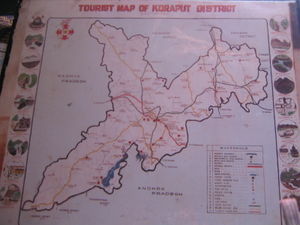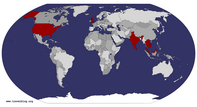Advertisement
Published: April 10th 2007

 orissa map
orissa map
We travelled the length of Orissa, from the northeast to the southwest and back. 1,000 KM on a 125cc bike... Marc and I left Varanasi, heading East towards Calcutta, the capital of West Bengal. I've always associated Calcutta with an overwhelming sense of poverty, an Orwellian layout of broken down buildings and ghettos filled with rubbish and wailing children begging for food. While I didn't find Calcutta overwhelmingly beautiful, I certainly didn't expect a booming Metropolis with a pretty chi-chi area filled with cafes and bistros with a skyline boasting one of the longest suspension bridges in the world. They also have a theme park called Science City, but that's definitely worth a miss, though I did get a mean plate of Chow Mein noodles in the cafeteria.
We spent an uneventful Easter morning in Calcutta, when Marc told me he wanted to show me something special -- a surprise. About 20 squelchingly hot blocks of pavement and huffing and puffing later, we arrived at the mission founded by Mother Theresa, where nuns were being instructed in a 5 year course before taking permanent vows. While the building was quite institutional and a bit over the top with shrines and memorials and a chance to walk up 14 floors of stairs (in 40 degree heat) to see the Mother's

 orissa beach
orissa beach
looks lovely, but the water was really dangerous and reeeeeally dirtyold dormitory room (?!!), it was beautiful to learn the story behind the mission and see the powerful effect Mother Theresa had on the world in terms of philanthropy and kindness.
From Calcutta, we headed south to Orissa, our original intention to visit Similpal National Park well-known elephant Reserve in Northern Orissa to check out some elephants, antlopes and hopefully tiger. Upon arrival to a dirty, dusty town near Similpal we met with the forest ranger who insisted on a fee that was way too high, plus the hire of a jeep and guide... Also we didn't get the impression we'd actually be able to see much wildlife. We quickly decided to move on and head to Puri, on the coast of the Bay of Bengal, to chill out on the sand and eat lots of great seafood and regroup for the next steps to come.
Bhubaneswar is the capital of Orissa and nearby, Puri is the site of the great Lord Jagannath temple, the most respected diety in Orissa. The annual festival, dating from ancient times, highlights a statue of the black-faced, white-eyed god being carted through the town pulled on a massive chariot. The chariot is
so large and heavey that over 100 devotees are needed to parade it through the streets. Inevitably, a handful of devotees would throw themselves beneath the wheels in a show of love, thus coining the phrase "Juggernut" -- a thing so large that it crushes you. Interesting the things you learn about everyday life in the most faraway corners of the world.
We were thrilled on arriving at the Z Hotel in Puri that it was exactly -- and more -- what I was hoping for... the former home of a Maharaja (Feudal King), with huge rooms filled with windows, light, clean sheets and beautiful colonial furniture. The drapes were spring green, the floors dark wood and the breeze fresh off the Ocean, divine.
We ate tons of fresh seafood, meandered down to the beach ... which was disappointingly stinky due to the lack of santiation in the area ... and did lots of reading and vegging out. This 'resort' town is divided to the North-East, where all of the foreigners stay, to the South-West, where all of the Indians-on-holiday-with-their-whole-entire-family stay. We checked out the beach one evening in the Indian side of town, and it was like

 Hell's Angels
Hell's Angels
okay, maybe not...a circus threw up on the beach, with candy, drinks, snack vendors tripping over the snake charmers and fire-toy throwers vying for our attention and rupees.
After a few days of R+R, we rented a 125cc motorbike (no helmets -- sorry, Mom!) to take a trip thru Orissa's hilly terrain and tribal villages. The entire trip was over 1,000 km and 6 days. The first day, we arrived after a few hours to a ferry to take us on a 3 hour ferry ride thru Lake Chillika, one of the largest lakes in Orissa. Only it was dry season, so the lake was over half way dried up and we had a 2-hour bike trip through the terrain and former islands as we headed further West. After too much sun and wind in the face, we found a room and had a few beers and watched some Guru TV (yes, this really is a network in India) and set out early the next morning where we'd really hit some more rural areas.
It was exhilirating to drive through the tea plantations, through the high, high hills, looking over the valleys below as we climbed into the Western part

 Shanty town
Shanty town
This was outside of Puri, a beach village
of the state. There were seldom few cars or motorcycles on the road, barring a few iconic white Ambassador taxis, local tractors hauling wood or tea and old women paving the higway alongside the road. How they got up there, I don't know, but all I do know is that the ladies are doing a lot more than the gentlemen when it comes to getting things done in India. It began to rain, big heavy drops like Shiva tears, and we still had a fair bit of windy mountain roads to go, but we pulled it through and made it to Malkangiri, in the Southernwest most part of the state. Here we would meet the Bonda tribes, an Austrailasian-ethnic group of peoples that are completely outside the Hindu way of life. It helps as well to understand that Orissa is a communist state and one of India's poorest (as opposed to Kerala -- communist and extremely wealthy), thereby confounding the problem of infrastructure, proper roads and, of course, education and social programmes.
Some Wikipedia info -- The Bonda are an ancient tribe of people numbering approximately 5000 who live in the isolated hill regions of the Malkangiri district of

 Beach market
Beach market
This was the night market on the Indian side of PuriSouthern Orissa India.
The Bonda are generally semi clothed with the woman characterised by the wearing of thick silver necklace bands. The tribe is one of the oldest and most primitive in mainland India with their culture little changed in over a thousand years. Their isolation and known aggression continue to preserve their culture despite the pressures of an expanding Indian population. The best way to view members of the tribe is by going to one of the local town markets. It is not considered safe to venture into their tribal areas. Click it -- http://en.wikipedia.org/wiki/Bonda_people
After a visit to the local tourism office to find out when the weekly bartering markets were held (the markets often used bartering as opposed to money), we realised our friendly local tourism guides had no clue what was going on in the area, so we headed out blindly to find some adventure. After several hours, we came upon a local bartering market and wandered around to experience one of the most basic stories of civilisation -- trading goods for others while living within a communistic, supportive community. Well, that's communism from a different perspective, I guess. We approached the far corner

 Lord Jagannath
Lord Jagannath
and his brother and sisterof the market where a huge circle of men and children had congregated, to see what all the fuss was about. Turns out it was a gambling circle. Eight tiles laid on the ground with two large picture die thrown around in a basket. We all threw rupees on the picture we thought the die would reveal Of course the Lord Jagannath picture mysteriously seemed to win quite a bit (except for whenever I threw down 10 rupees on that tile). I was surprised to see the reaction after I -- a white woman -- joined in on the game. They waited to see what I would put my money on, and then either joined in on my bet in the hope I was a magic woman, or chuckled and shook their heads and made their own bets (and consequently, won). Our French and English here were useless. Our Hindi moderately helpful. Sign language was the best option, and we eagerly agreed as we bet, tried some rice fermented beer drink (which sounds far better than it tastes -- blerg) and soak up the atmosphere.
One day, we were on the southern-most area of our trip in Balimela, which
has a huge hydro-electric plant and apparently (at the moment) a lot of Russian engineers working their tirelessly to finish a contract on a few other plants. We drove through the hills, looking for Bonda villages, and came upon one village at the end of a dirt road. I thought I was in Africa. Women with bare breasts and African-printed saris, children with malnutrition-charged bellies, gaping jaws and erratic language erupting as soon as we approached. We tried to find out the name of the village and passed around ciggarettes to all the men, but some of the women were looking a bit shifty and one grandma eventually had her say in Bonda -- people chuckled -- but we didn't want to push it, and moved on. It was a lovely interaction and such and example of two worlds looking in to the one another.
I will never forget our afternoon driving on a single paved road through the flat lands, with massive hills like mountains peeking through the distant horizan. I drove the bike a tiny way as Marc took photos, but after the rain set in we pulled into a tiny bus stop to wait it out.
We were across the road from a tiny village and within 10 minutes they were all at the bus stop, staring at us, laughing, smiling and staring at my green eyes and white skin. I had bought lots of chewing gum in town earlier in the day in case I met some kids, and I played a little game where I pointed at a child and he or she had to run up to me to grab some gum. In a way, I guess you can say don't give out things, but this was really a lovely moment about finding a way to share a laugh with kids when we had no language and no other way to connect, especially from our outward appearances. It was the only way I could think of and I'm so glad it happened.
This moto-cross trip encapsulated the paradox of India. One billion people, completely different realities from Lakshmi Mittal, the fifth richest man in the world, to tribal peoples living the same way they did a thousand years ago. Despite a pretty sore bum, a sunburn and an out-of-this-world desire for a peanut butter sandwich or ANYTHING that wasn't served with rice

 Road traffic
Road traffic
There was everything from tractor-trailers, motorcycles and oxcarts on the Orissa highways.and dal, it's something I'll always treasure and remember. Thanks for driving, Marc ; )
Advertisement
Tot: 0.213s; Tpl: 0.012s; cc: 17; qc: 76; dbt: 0.0934s; 1; m:domysql w:travelblog (10.17.0.13); sld: 1;
; mem: 1.3mb





















Rajat
non-member comment
wow
tryin 2 imagine da beau drives thru hills u have talked bout. :)